

Eagle Valley is known locally as the "banana belt" of Baker County, Oregon, but the valley's climate is far from tropical (as is true of the major wine growing areas of eastern Washington and Oregon). High and low temperatures reflect a continental climate and can be extreme--much more so than west of the Cascade Mountains, where marine effects are substantial.
Two Josephs Vineyard is located on the valley floor, and therefore we are less protected against frost than hillside sites in Eagle Valley. Temperature sensors show our land overlooking Brownlee Reservoir to be 1-2° F warmer during frost events than our vineyard site. The traditional fruit growing areas of New Bridge are likely to be even warmer.
We have recorded temperatures in the vineyard during the past three winters (although we do not have the dates of last frost for two years) using Hobo data loggers:
The Western Regional Climate Center has Eagle Valley weather data spanning a 40 year period. Figures 1-6 (below) are from data for the period 1970-2000. For comparison, we also show data for the Yakima Valley (Prosser, WA), the Walla Walla Valley (Milton-Freewater, OR), and the western Snake River Valley (Parma, ID). All three areas have significant wine grape production.
NOTE: these data have limitations for assessing the wine growing potential of Eagle Valley. First, the 30-year averages underestimate the current effect of global warming on valley temperatures. Additionally, the local weather station is located in the town of Richland, Oregon, which is situated on flat land in the center of the valley, where risk of radiative frost is highest. Experience shows significant frost protection on a range of sites around the valley, particularly in the former fruit growing areas near New Bridge.
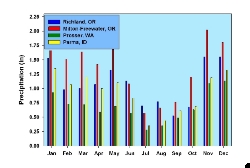
Average annual rainfall in Eagle Valley is 12.8 inches, which is less than occurs in Milton-Freewater (14.5") and more than in Parma (10.2") and Prosser (7.9"). As Figure 1 shows monthly precipitation is generally greatest in November through May. The growing season is dry with occasional rain from thunder showers. Agricultural water in the valley is provided by several irrigation ditches that are fed by snow melt from the Eagle Cap/Wallowa mountains. Dry summer months, plus the availability of high quality irrigation water, make possible the careful regulation of irrigation to improve grape quality.
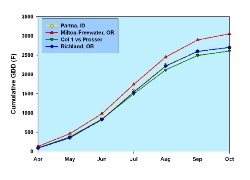
To produce a quality wine, grapes must be picked at physiological ripeness, which is largely a function of heat accumulation. GDD (annual growing degree-days) is a commonly used index of heat accumulation, and is a reflection of the number of days during the growing season (April-October) with temperatures above 50° F. Figure 2 shows the GDD for Eagle Valley (Richland, OR) and the Walla Walla (Milton-Freewater, OR), Yakima (Prosser, WA), and western Snake River valleys (Parma, ID).
Figure 2 also shows Eagle Valley's temperature pattern is nearly identical with that of the western Snake River Valley (Parma, ID) and is a bit warmer than the Yakima Valley (Prosser, WA). However, the Walla Walla Valley (Milton-Freewater, OR) is much warmer than Eagle Valley. The cumulative GDD for Eagle Valley is 2700, which places the valley in Winkler Region II (the same as Bordeaux, the Rogue River Valley, and colder portions of the Napa and Sonoma Valleys). Region II is generally suitable for production of early and mid-season grapes such as Chardonnay, Sauvignon Blanc, Syrah, Merlot and Riesling.
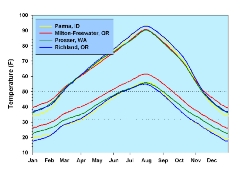
In general, high quality wine grapes achieve physiological ripeness while retaining the acidity, which provides freshness. Warm days and cool nights are believed to contribute to this condition. Figure 3 shows average daily high and low temperatures for Eagle Valley. During the growing season, average daily temperatures are higher in Eagle Valley than in either the Walla Walla (Milton-Freewater) or Yakima (Prosser) Valleys. Nighttime temperatures are lower in Eagle Valley. As a result, the daily swing in temperatures in Eagle Valley exceeds that seen in either the Walla Walla or Yakima Valleys. This condition may improve grape quality, but directly contributes to high risk of early and late frost.
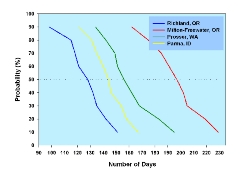
Figure 4 shows Eagle Valley has an average growing season of 152 days between hard frosts (< 29° F). This growing season is too short to achieve physiological ripeness in many varieties of wine grape. The figure shows the Walla Walla Valley (Milton-Freewater) has approximately 50 more growing days per year than Eagle Valley, while the growing season in the western Snake River (Parma) is about 2 weeks longer.
Figure 5 shows fall killing frosts in Eagle Valley and the western Snake River valley (Parma) occur at about the same time, but about 2 weeks before the Walla Walla and Yakima Valleys.
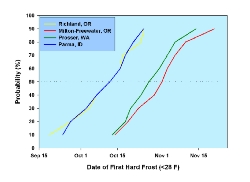
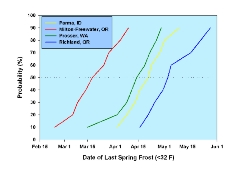
Figure 6 shows May 3rd is the average last day for a hard spring frost (< 29° F) in Eagle Valley. This is about 2 weeks after the last hard frost in Parma and 6 weeks after Milton-Freewater.
The weather data show the principal barriers to wine grape production in Eagle Valley are spring and fall frosts. Importantly, Figure 3 shows daytime temperatures in Eagle Valley are a bit higher than in the Walla Walla, Yakima or western Snake River Valleys during the months of April and October, when risk of frost is great. This suggests that the length of the growing season could be profitably extended if adequate frost protection could be provided, or protective vineyard sites were selected.
The principal barrier to extended ripening of grapes in Eagle Valley is radiation frost. Radiation frost occurs when daytime heat is lost by radiation on calm, clear nights. The result is an inversion layer with cold air at ground level and warmer air above. Wind machines, which mix the warm and cold air, are one means for fighting radiation frost. Sprinklers are another. A third less expensive and more reliable approach is careful site selection.
Experience has shown a range of mesoclimates exist in Eagle Valley that are protected against radiation frosts. The former fruit production area near New Bridge is one such area. Prime sites for vineyards in Eagle Valley are likely to be on the southwest facing slopes of the "orphan hills" to the northeast of the valley (if the land has water rights).